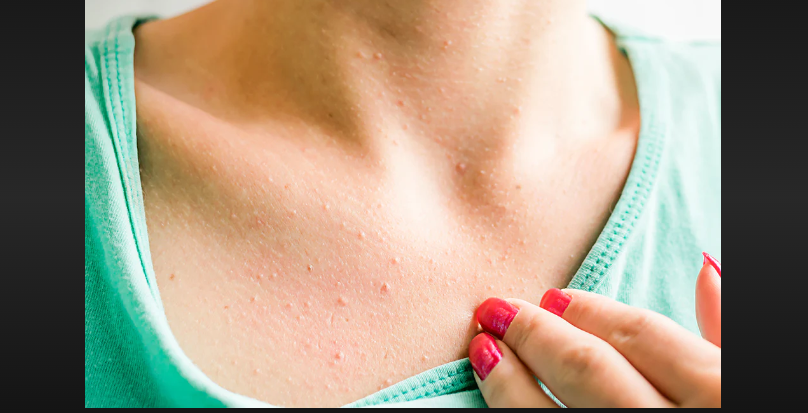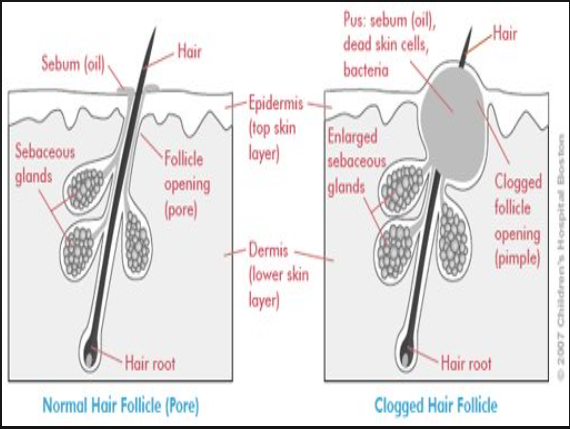Understanding and Dealing with Clogged Pores on Breasts
Clogged pores are a common skin concern that can affect various parts of the body, including the breasts. While clogged pores on the face are widely discussed, clogged pores on the breasts are less frequently addressed. In this article, we'll delve into the causes, prevention, and treatment of clogged pores on breasts, offering valuable insights for those dealing with this issue.

Clogged pores on breasts
1. The Basics of Clogged Pores
Clogged pores, also known as comedones, occur when dead skin cells, oil, and debris accumulate within hair follicles.
This can lead to the development of whiteheads or blackheads, depending on whether the pore is open or closed.
2. Causes of Clogged Pores on Breasts
Clogged pores on the breasts can be attributed to several factors, including:
-
Sweat and Friction: The breasts are susceptible to sweat accumulation, especially in areas where the skin rubs against clothing. Sweat can mix with natural body oils and dead skin cells, leading to clogged pores.
-
-
Tight Clothing: Wearing tight or non-breathable clothing can trap sweat and debris against the skin, contributing to clogged pores.
-
-
Poor Hygiene: Inadequate cleansing of the breast area can lead to the buildup of dirt, sweat, and oils, increasing the likelihood of clogged pores.
3. Prevention Strategies
To prevent clogged pores on the breasts, consider the following tips:
-
Choose Breathable Fabrics: Opt for breathable fabrics that allow air circulation, reducing the risk of sweat and debris buildup.
-
-
Maintain Proper Hygiene: Cleanse the breast area gently but thoroughly during your daily shower routine to remove excess sweat and oils.
-
-
Avoid Harsh Products: Using harsh or abrasive cleansers can strip the skin of its natural oils, potentially exacerbating clogged pores. Opt for mild, non-comedogenic products.
4. Treatment Options
If clogged pores develop on your breasts, here are some approaches to consider:
-
Gentle Exfoliation: Use a mild exfoliating scrub to help remove dead skin cells and unclog pores. Be cautious not to scrub too vigorously, as this can irritate the skin.
-
-
Topical Treatments: Over-the-counter creams containing salicylic acid or benzoyl peroxide can be applied to the affected area to help clear clogged pores.
-
-
Warm Compress: Applying a warm, damp cloth to the clogged pores can help soften the debris and make it easier to remove.
5. When to Seek Medical Attention
In some cases, clogged pores can become infected or develop into more severe skin issues.
If you notice persistent redness, swelling, pain, or discharge from the clogged pores, it's advisable to consult a dermatologist for proper evaluation and treatment.
6. Embracing Self-Care
Caring for your skin goes beyond addressing specific issues.
Maintaining a consistent skincare routine that includes gentle cleansing, moisturizing, and sun protection can contribute to overall skin health, including the breast area.
7. Breaking the Silence
While clogged pores on the breasts might not be a common topic of discussion, it's important to break the silence surrounding this issue.
By sharing information and experiences, individuals can find support and guidance in managing and preventing clogged pores.

Clogged pores
Clogged pores on the breasts can be a discomforting concern, but with proper care and attention, they can be managed effectively. By adopting preventive measures, seeking appropriate treatments, and prioritizing skincare, individuals can promote healthy and radiant skin on all parts of their body, including the breasts. Remember that everyone's skin is unique, so it may take some trial and error to find the right approach for your individual needs. If you're unsure about how to address clogged pores, consulting a dermatologist can provide personalized guidance and solutions.